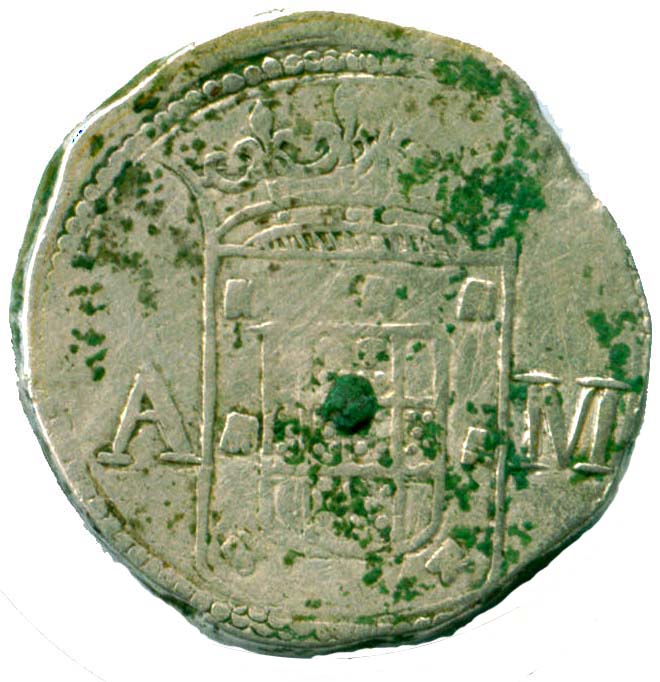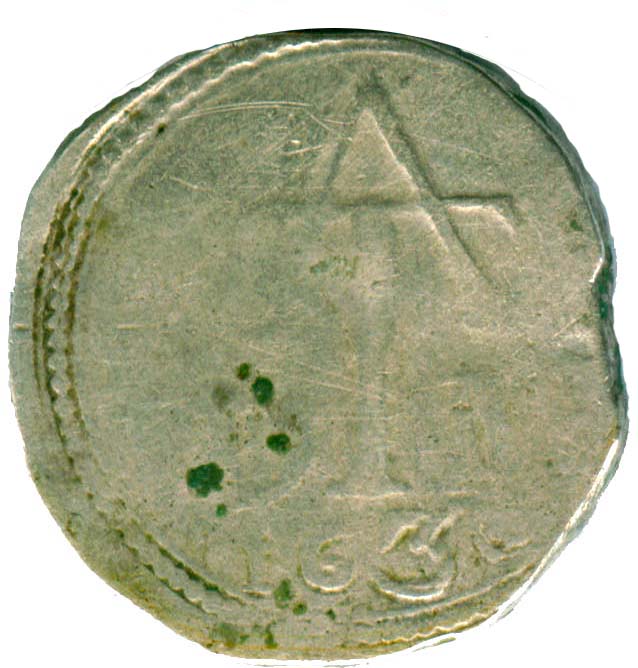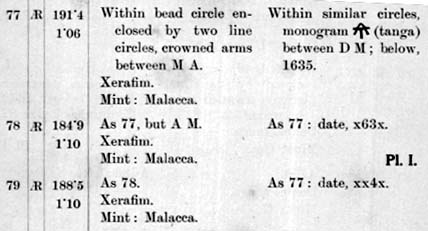| Denomination | Xerafim |
| Alloy | Silver |
| Type | Struck |
| Diameter | 27.0 mm |
| Thickness | 2.4 mm |
| Weight legal | 12.45 gms |
| Weight | 12.33 gms |
| DieAxis | 200° |
| Mint | Malacca/Goa |


|

|

| ||||||||||||||||||
| Gomes ; F.Vaz F3:21 ; Grogan 1315; KM #?? | ||||||||||||||||||||
Obverse : Crowned Coat of arms of Portugal divides A M (Asia Malacca)
within a circle of dots between two plain line circles.
Reverse : TA (Tanga Asia) monogram divides
D M (De Malacca) with year I636
below, Within a circle of dots between two plain line circles.
Codrington (VIII-25:III,p.102) on Malacca says Larger silver coins dated from 1635 to 1640 are also found in Ceylon; these are of the usual Malacca type and weigh from 12.0 to 12.4 grams, the average being 12.24 ; their halves weigh from 5.9 to 6.1 grams with an average of 6.00. Xerafins and half xerafins of this type were ordered to be struck at Goa in 1637 with the weights of 15.56 and 7.78 grams respectively. The coins found in Ceylon, however, are considerably lighter and, as suggested by Grogan, must have been intended for quadruple and double tangas weighing 12.45 and 6.26 grams each. It is possible that they were reckoned in Ceylon as whole and half xerafins, as being 5 and 2.5 times the weight of the local tanga. ... By the end of 1634 the royal order forbidding coinage except at Goa had been received, and as all the dated pieces are of similar workmanship, it seems probable that all were struck at Goa and not at Malacca.
The 1914 catalog of coins of the Colombo Museum by H. W. Codrington mentions them as Xerafim lists 3 full(#77,78,79) and 2 half coin. The illustrated image of #78 closely but not exactly resembles this coin. However the coin illustrated in Grogan has a significantly different die with a narrower shield and a shorter T in TA monogram. These are characteristics of the later 1636-1638 Quad Tanga illustrated in Indo Portuguese Money by J. Ferraro Vaz (Braga 1980) p.147. The wider shield and Taller T in TA monogram was probably used 1633-1636 including the transition year.
The Colombo museum coins contradicts the contemporary Grogan 1914 Auction catalog lot#1315 description (shown below) which called that unique and consequently sold for 230 Guilders (27.6 gold sovereigns).
See also modern replica of this Quad Tanga also called in Ceylon as Xerafim.
The uncleaned VF/F grade coin was scanned at 600 dpi and displayed at 250 dpi. It was obtained in 2011 December from a Lankan Dealer as part of a small hoard of coins claimed to have been found in Ampara District consequent to Bombing during the 26 year civil War which ended in 2009.
Text from
* Ceylon Coins and Currency By H. W. Codrington. Colombo 1924
Chapter VIII Portuguese - III Malacca 24, P102
* Indo Portuguese Money, by J Ferraro Vaz, . Braga, Portugal 1980
* Collection Henry Thomas Grogan, J. Schulman, Auction 23-02-1914.
* Indo-Portuguese Numismatics, Spink Numismatic Circulars. 1911-14 1916



